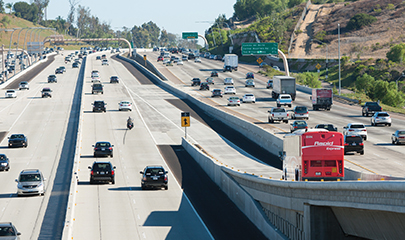
San Diego roads and highways. (Photo: SANDAG.org)
CA Auto Insurance Policies Will Rise By 54% Compared to Last Year
Rates are currently 45% higher than last years auto insurance premiums
By Evan Symon, August 16, 2024 12:02 pm
According to a new study released Friday by Insurance tracking company Insurify, auto insurance rates in California will go up as much as 54% compared to where they were last year.
For over a year, insurance companies have been slowly limiting policies, ending the allowance of new policies, or generally reducing their presence in the state. In 2022, GEICO closed down all 38 of their offices in the state, with State Farm raising auto insurance rates in March of 2023. However, the largest action came in May 2023 when State Farm Insurance announced that they would no longer be accepting new applications for any kind of insurance other than personal vehicle insurance because of large increases in construction costs and inflation. About a week later, it was revealed that Allstate had done the same thing, stopping all new homeowners insurance policies for the last several months. Later in the year, Farmers announced new limits on the number of new homeowner insurance policies it will give each month, with numerous other insurance companies, such as Liberty Mutual, no longer offering certain policies in the state.
Other major insurance limiting factors soon struck the state as well. In August 2023, Farmer’s announced 2,400 layoffs, with nearly all companies raising rates by at least 20% in late 2023 and early 2024, including State Farm. For the companies, the reasons were simple: large increases in construction and reconstruction costs, a rise in crime, inflation, and a largely increased risk of danger because of more wildfires. In March, State Farm also made the drastic decision to remove 72,000 insurance policies in the state, roughly 2% of their total number in California. Two months later, both the Tokio Marine America Insurance Company and the Trans Pacific Insurance Company announces that they would be pulling completely out of California, ending over 10,000 home and umbrella insurance policies. Finally, more home insurance rate increases have also been announced, including 15% for Travelers, up to 50% for State Farm, and 34% for Allstate.
While initially unaffected, car insurance rates soon faced rising costs too. Inflation, traffic volume, and a rise in accidents and crime have been the main instigators. A major rise in losses, caused by the rising costs or repairing or replacing cars and more accidents causing them, have also been blamed. Earlier this year, finance company Bankrate found that, when compared to last year, Los Angeles drivers had been paying 26% more for premiums compared to last year, showing a significant rise. However, on a state scale, things grew worse, leading to the Insurify report on Friday.
A projected 54% rate increase in CA
According to the report, the average annual cost for full coverage on a car was $1,666 in June 2023, compared to $2,417 in June 2024 and a projected $2,681 for December 2024. Currently, the year over increase is at 45%, but with the December projected amount, premiums could go up in California by 54% in only a years time. Nationwide, premiums have only gone up by 28% on average, leaving California as one of the highest cost states in the country. In their report, Insurify noted that California’s premium rises have had a special reason behind such the rises: frozen insurance rates during the COVID-19 lockdown instituted by the state ending, and insurance companies boosting up the rates to return to being in the black.
“Rate increases in 2024 are largely a continuation of hikes in 2023, a year that saw full-coverage premiums rise by 24% in response to insurers’ record underwriting losses ($33.1 billion) in the year prior,” read Insurify’s report on Friday. “Underwriting losses decreased to $17 billion in 2023 — a financial hit that was still substantial enough to drive significant rate hikes in the first half of 2024.
“Insurer losses result from a combination of inflationary pressures — like the rising cost of vehicle repairs and the skyrocketing price of new cars — and unprecedented climate catastrophes that drive weather-related claims in states that haven’t historically seen as much of this type of damage. These costs strain insurers’ budgets as they pay out more than they earn in profit.
“Additionally, legislative changes in states like South Carolina and Maryland have increased insurers’ financial responsibility, leading them to charge higher premiums. In California, which froze insurance rates during the COVID-19 pandemic, some insurers are requesting double-digit hikes as they struggle to return to profitability, while others are exiting the state entirely.”
The increasing rates will likely hurt more California drivers as the year progresses, with no halt in costs in sight.
“They’re only going to go higher,” said Trevor Connery, a lobbyist who has worked for insurance companies in the past, to the Globe on Friday. “That freeze in rates is a big part of this, but so is inflation, higher costs, more accidents. And with higher premiums, more people become uninsured. So when those accidents happen, it just continues the cycle of higher costs.
“Insurance is a necessity for every driver in the state, and sadly, that means everyone is feeling the pinch.”
More finite reports on where rates will land at the end of the year are due in the coming months.
- Bill to Require Law Enforcement Disclosure if AI Was Used To Help Write Reports - August 7, 2025
- Gov. Newsom Files FOIA Request To ‘Expose True Cost’ Of L.A. Federal Troop Deployment for Anti-ICE Riots - August 6, 2025
- California Redistricting: How Newsom’s Plan Will Demolish Hard Fought GOP Gains - August 6, 2025





It is a convergence of high tech cost repairs, more uninsured drivers(increased hit and runs) less competition and regulations.
It is becoming unaffordable for many to own a car. Could this be part of the global elite to push us out of car ownership? It makes one wonder!
I don’t understand why I have to pay full insurance premiums on each of my cars. I pay the full insurance premium on my wife’s car, not a problem. I pay the full insurance premium on my daily driver, not a problem. But I also pay the full insurance premium on my weekend car. I can’t drive 2 cars at the same time so why do I have to pay the full insurance premium for 2 cars at the same time. I do get a multi car discount but I would get that anyway with my wife’s car.
More and more people are driving stoned on marijuana. THC from marijuana, not alcohol, is now the most commonly detected intoxicant in U.S. drivers.
From a study in Canada,
“In marijuana-involved accidents, nearly 90% of the victims arrived by ambulance, the study found. When no alcohol or cannabis was involved, the number of people that required an ambulance dropped to 40%. In addition, nearly 50% of marijuana users in a car accident required hospital admission, compared to just over 6% of those who did not use. Nearly 22% of accidents involving those driving while stoned needed intensive care, compared to just less than 2% of crashes without alcohol or cannabis involvement.”
What climate caused car damage? Sounds like an excuse designed to make rate hikes palatable to greens. I challenge the insurance companies to come up with a single example of “climate killed my car”.
When politicians and companies don’t have a reasonable excuse, they blame “climate”, even though the climate hasn’t changed..
Almost EVERYTHING has gone up in price under the Biden and Newsom regimes? They and the rest of the criminal Democrat mafia in power come up with lamebrain excuses like climate change and a lack of equity? They promise things will be different if we just forget and be unburdened by the past and allow them to raise taxes and issue their dictatorial mandates like price controls? When will we be free of these demonic thugs?
Consider this. What has happened in your personal economic world in the past 3-4 years while the democrats have controlled the trajectory of the country? Do you want to see four more years of this insanity? Excessive government spending is always the biggest contributor to cost-of-living escalation.
This alone should be enough of a wake-up call for every registered voter in the U.S.